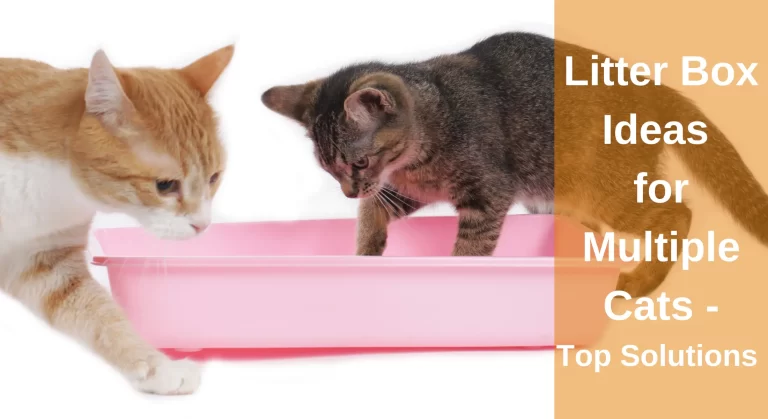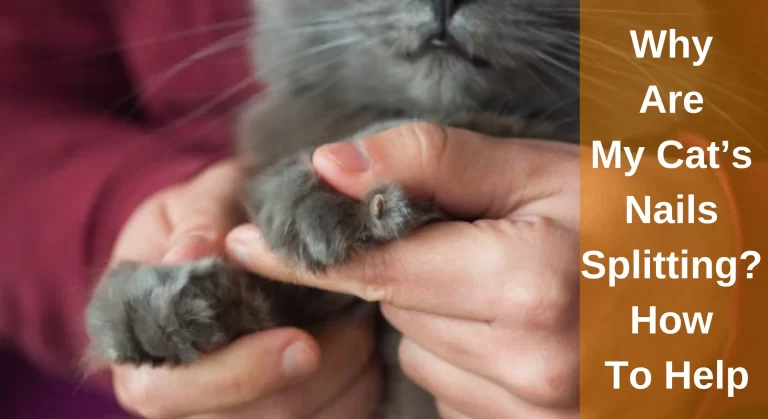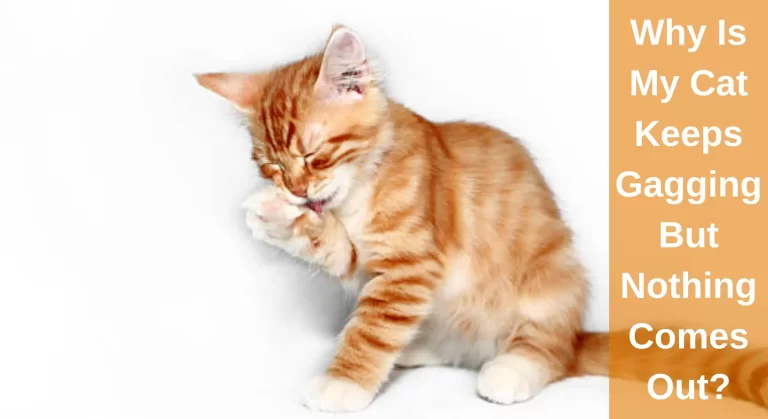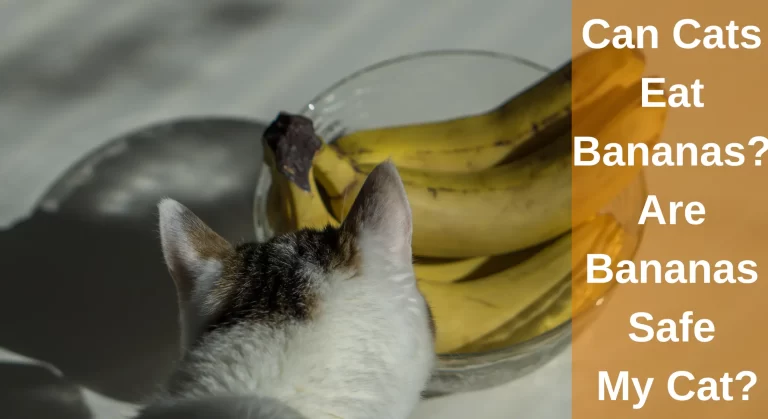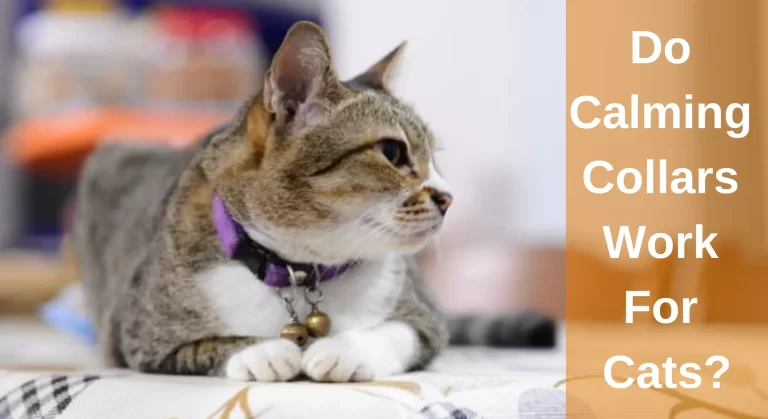My Cat Keeps Going to the Litter Box But Nothing Happens! Is That A Serious Issue
When your cat uses the litter box, you generally don’t pay much attention until they leave a really awful deposit. After all, everyone poops, and your cat’s litter habits blend into life outside the box scooping routine. Your cat could, however, occasionally cease using the toilet as regularly.
You may wonder what’s happening and whether you should be concerned if your cat keeps going to the litter box but nothing happens. Actually, your cat’s unusual behaviour might have a variety of causes.
If your cat keeps going to the litter box, but nothing happens, it could be due to a medical condition, behavioral issue, or litter box problem.
In this article, we’ll talk about a few possible reasons why your cat may be using the litter box more frequently, one of which may be a significant emergency. Furthermore, we’ll let you know what you can do to influence the behaviour.

Understanding Cat Litter Box Behavior
Cats are fastidious creatures that take their litter box behavior seriously. They prefer a clean and private place to eliminate waste and will often display certain behaviors to indicate that they are not feeling well or are unhappy with their litter box situation. If your cat is frequently going to the litter box, but nothing is happening, it’s time to investigate the possible reasons why.
Several factors may be causing your cat to display this behavior. The most common reasons include medical conditions and behavioral issues.
Medical Conditions: The cat Keeps Going to the Litter Box But Nothing Happens
If your cat goes to the litter box but is not urinating or defecating, it could be due to a medical condition. A variety of medical conditions can cause this behavior:
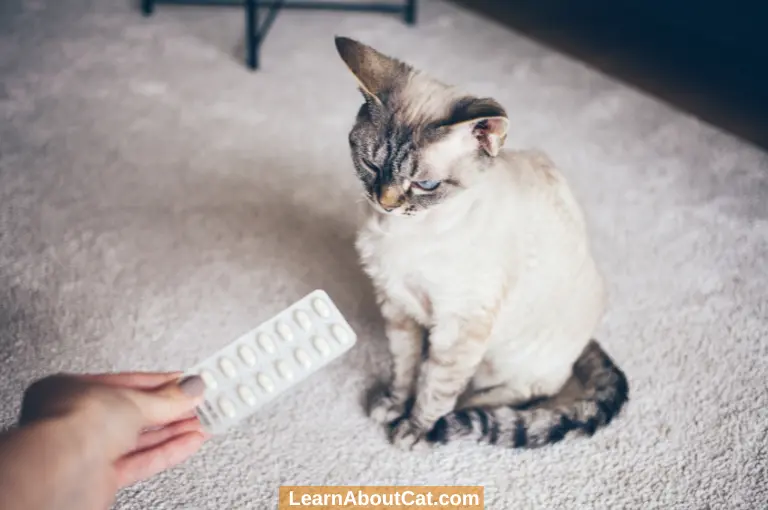
1. Constipation
Constipation is a prevalent problem in cats. If your cat is experiencing constipation, it may visit the litter box but not produce any feces.
Dehydration is one of the primary causes of constipation in cats. A diet-related problem also causes constipation due to a lack of fibre in the diet. Like people, cats that eat diets lacking in fibre have trouble going to the bathroom.
Symptoms
If your cat is constipated, it may exhibit the following symptoms:
- Infrequent or absent bowel movements
- Straining or discomfort during the elimination
- Small, hard, or dry feces
- Lethargy or decreased appetite
- Vomiting or abdominal pain
Causes
Several factors can contribute to constipation in cats, including:
- Dehydration
- Lack of exercise
- Ingestion of hair or foreign objects
- Obesity
- Changes in diet or feeding schedule
- Underlying medical conditions such as megacolon or tumors
Check Out: How to Get Your Cat to Drink More Water (Trips & Tricks)
Treatment
If you notice your cat displaying constipation signs, refrain from treating him at home. This is one way that constipation treatments for cats and people differ. Giving cats human drugs without a veterinarian’s approval runs the danger of causing more harm than benefit.
The best course of action is for you to take your cat to the vet if you think she could be constipated. The veterinarian will inspect your pet while you’re there to decide the best course of action for your cat.
Your veterinarian will suggest a few kinds of cat food for you to pick from if your cat has constipation due to consuming too little fiber. Laxatives, probiotics, and stool softeners are further therapies for constipated cats.
Prevent Constipation
- Make Certain Your Cat Consumes Water: Purchase a metal or ceramic dish to encourage your cat to consume more liquids. Ensure the dish is large enough so the sides don’t touch your cat’s whiskers. Place a few extra bowls of water in useful spots throughout your house. You may wish to purchase a water fountain if your cat likes the sound of running water. While you and your cat are in the kitchen, you may leave the faucet open as an alternative.
- Encourage Your Cat to Explore More of the Room: Your pet’s internal organs, including his digestive system, move while he exercises. Your cat will be able to discharge himself frequently as a consequence, preventing constipation. You can play with them daily to encourage him to move around more. Try to spend at least 20 minutes of playtime with him every day. You may break up those minutes into smaller units to accommodate your timetable.
- Consider Adding Fibre to Your Cat’s Diet: Fibre helps avoid constipation. In this regard, ask your physician about the best cat food and feeding techniques.
2. Urinary Blockage
One of the most common reasons a cat might go to the litter box, but nothing is happening, is a urinary blockage. This occurs when something obstructs the urinary tract, making it difficult or impossible for your cat to urinate.
Crystals that form and amass in the bladder, urethra, or anywhere else in the urinary tract are typically to blame for this. If they accumulate sufficiently, they may totally block the urine’s flow, making it very difficult for your cat to pee.
Symptoms of Urinary Blockage in Cats
Some of the most common symptoms of urinary blockage in cats include:
- Frequent trips to the litter box without producing any urine
- Straining to urinate
- Crying out in pain while trying to urinate
- Licking their genitals excessively
- Blood in the urine
- Loss of appetite
- Vomiting
Causes of Urinary Blockage in Cats
Several factors can contribute to urinary blockage in cats, including:
- Diet: Feeding your cat a diet high in magnesium and phosphorus can increase the risk of urinary blockage.
- Dehydration: Cats that don’t drink enough water are at higher risk of developing urinary blockages.
- Stress: Blockages in the urinary tract are more likely to occur in stressed or anxious cats.
- Gender: Males are far more likely to acquire a blockage because their urethra is much longer and narrower than females.
Treatment for Urinary Blockage in Cats
Urinary blockage is a serious medical emergency that requires immediate veterinary care. Your veterinarian may recommend a combination of medications, IV fluids, and catheterization to relieve the blockage and prevent it from recurring. In severe cases, surgery may be necessary.
3. Bladder Infection
Another common reason why a cat may repeatedly be going to the litter box without producing urine or feces is a bladder infection. Infections of the urinary tract are caused by bacteria entering the tract.
When the bladder lining is severely inflamed and swollen, urine cannot pass through it. Bladder stones and mineral build-ups inside the bladder may also be there in your cat. Larger ones can stop urine from traveling through the tract; they exist in various sizes.
Symptoms of Bladder Infection in Cats
Some of the most common symptoms of a bladder infection in cats include:
- Frequent trips to the litter box without producing urine
- Straining to urinate
- Blood in the urine
- Urinating outside the litter box
- Licking their genitals excessively
- Loss of appetite
- Vomiting
Causes of Bladder Infection in Cats
Bladder infections in cats can be caused by a variety of factors, including:
- Bacteria: Cats’ most common cause of bladder infections is bacteria, which can enter the urinary tract through the urethra.
- Urinary tract abnormalities: Cats with urinary tract abnormalities, such as bladder stones or tumors, are at higher risk of developing bladder infections.
- Diabetes: Cats with diabetes are more prone to developing bladder infections.
- Weakened immune system: Cats with weakened immune systems, such as those with FIV or FeLV, are at higher risk of developing bladder infections.
Treatment for Bladder Infections in Cats
If your cat is diagnosed with a bladder infection, your veterinarian will likely prescribe antibiotics to clear up the infection.
It’s important to administer the antibiotics exactly as prescribed and ensure your cat drinks plenty of water to flush out the bacteria. Some veterinarians recommend special diets or supplements for cats with urinary tract disorders.
4. Urinary tract infection (UTI)
Urinary tract infections (UTIs) are also common in cats. The disease is caused by bacteria that invade the urinary tract and is uncomfortable and painful for those who suffer from it.
Symptoms of UTI in Cats
Some of the most common symptoms of a UTI in cats include the following:
- Frequent trips to the litter box without producing urine
- Straining to urinate
- Blood in the urine
- Urinating outside the litter box
- Licking their genitals excessively
- Loss of appetite
- Vomiting
Causes of UTI in Cats
UTIs in cats are typically caused by bacteria that enter the urinary tract through the urethra. Female cats are more prone to UTIs due to their shorter urethras, which make it easier for bacteria to enter the bladder.
Treatment for UTI in Cats
If your cat is diagnosed with a UTI, your veterinarian will likely prescribe antibiotics to clear up the infection. It’s important to administer the antibiotics exactly as prescribed and to make sure your cat drinks plenty of water to flush out the bacteria. Your veterinarian may prescribe a special diet or supplement to maintain your cat’s urinary tract health.
5. Feline urethral obstruction (FUO)
Feline urethral obstruction (FUO) is a condition where there is a blockage in the cat’s urethra, which prevents them from urinating properly. The condition can be uncomfortable and painful; if left untreated, it can be life-threatening.
Symptoms of FUO in Cats
The symptoms of FUO in cats include:
- Repeated attempts to urinate with little or no urine produced
- Crying out in pain while attempting to urinate
- Lethargy and depression
- Vomiting
- Loss of appetite
- Swollen or tender abdomen
Causes of FUO in Cats
FUO is most commonly caused by bladder stones, which can block urine flow through the urethra. Inflammation or narrowing of the urethra can also cause a blockage.
Treatment for FUO in Cats
It is a medical emergency situation that requires immediate attention by a veterinarian Treatment typically involves relieving the blockage by flushing the urinary tract or surgically removing the blockage. If the condition is severe, a urinary catheter may be required to allow urine to flow. Your veterinarian may also prescribe medication to relieve pain and
6. Feline idiopathic cystitis (FIC)
Feline idiopathic cystitis (FIC) is a condition that affects a cat’s urinary bladder. It is the most common cause of urinary tract problems in cats. FIC can cause discomfort and pain.
A bacterial infection, a mineral imbalance, and abnormal pH levels can all contribute to cystitis, an bladder inflammation. The growth of minute mineral crystals in a cat’s urine is known medically as cystitis.
Symptoms of FIC in Cats
The symptoms of FIC in cats are similar to those of other urinary tract problems, including:
- Frequent trips to the litter box without producing urine
- Straining to urinate
- Blood in the urine
- Urinating outside the litter box
- Licking their genitals excessively
- Loss of appetite
- Vomiting
Causes of FIC in Cats
FIC is believed to be caused by various factors, including stress, diet, and genetics. Stressful events, such as a move or the introduction of a new pet, can trigger the onset of FIC in susceptible cats.
Treatment for FIC in Cats
Treatment for FIC in cats typically involves managing the symptoms of the condition. Your veterinarian may prescribe medication to relieve pain and reduce inflammation. It’s also important to provide your cat with a low-stress environment and plenty of opportunities for play and exercise.
Behavioral Issues: Cat Keeps Going to the Litter Box But Nothing Happens
Behavioral issues can also cause cats to exhibit this behavior. Some of the most common behavioral issues that can cause this behavior include:
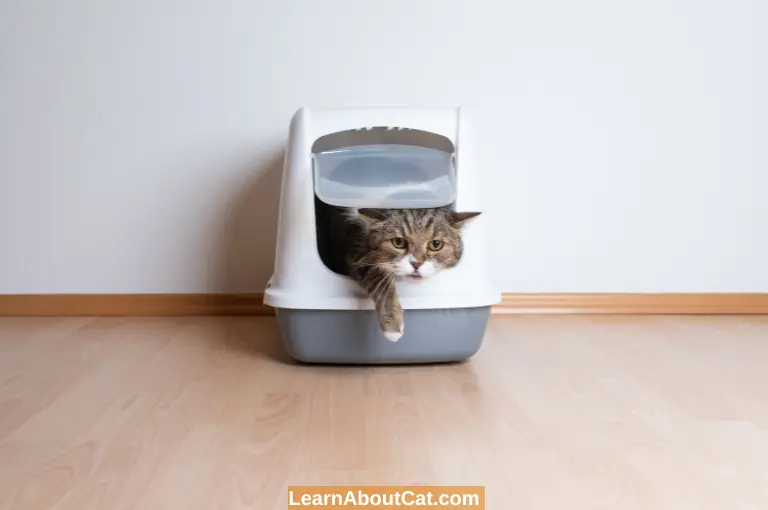
1. Your Cat is Distressed and Worried
Another cause of your cat’s frequent visits to the litter box but lack of excrement or urination is stress or worry. Cats are creatures of habit, and changes in their routine or environment can cause them stress and anxiety.
When stressed, cats typically retreat from their surroundings and seek refuge. They may choose to hide on your home’s high shelves, under your bed, or in a cat condo. On the other hand, their litter box is another little, safe place cats may hide.
Signs of Stress in Cats
Some of the most common signs of stress in cats include:
- Changes in appetite
- Increased or decreased vocalization
- Hiding or avoiding interaction
- Urinating or defecating outside the litter box
- Excessive grooming or licking
- Aggression toward people or other animals
Causes of Stress in Cats
Many factors can cause stress in cats, including:
- Changes in the household, such as a new pet or a move to a new home
- Lack of stimulation or playtime
- Medical issues, such as pain or illness
- Separation anxiety
- Loud noises or unexpected events
Treatment for Stress in Cats
If your cat exhibits signs of stress or anxiety, it’s important to identify and address the underlying cause. Providing plenty of playtimes, hiding spots, and scratching posts can help alleviate stress and provide a sense of security. Sometimes, your veterinarian may recommend anti-anxiety medication or behavioral therapy to help your cat feel more comfortable and relaxed.
2. Your cat Is Inquisitive
Cats are typically inquisitive creatures, but kittens may be more puzzled and fascinated by the world than older cats. It’s not a myth that “curiosity killed the cat”! Therefore, if your cat uses the litter box frequently but nothing happens, they could find it amusing.
If you’ve always used the same litter box and cat litter, the likelihood of this happening is reduced. But did you buy a fresh litter box? Have you switched the litter your cats use? Have you relocated the litter box in your home? So, your cat may be curious.
3. Your Cat Is Making a Dominant Play
Your cat may also act domineeringly if it does nothing but sit in the litter box. Only cat owners with plenty of cats can pull this off. Your cats may get along well, but there will be social order, and each cat will respect and want its own space. By utilizing the litter box, your cat lets the other cats know it is her domain.
As a result, your second cat or cat can quit using the litter box, which might lead to a completely separate issue. After all, where should cats discharge themselves if another cat is in their way? As a result, poop and pee may ensue.
4. Your Cat is in Labour
If your pregnant cat uses the litter box as usual, but nothing occurs, she may be on the verge of giving birth there. Your cat could have chosen the litter box as their delivery place since it is hidden and covered.
The litter box still harbors germs regardless of how well you keep it clean, which raises the risk of disease for both the mother and the kittens. You must offer your cat access to a second peaceful nesting box so that she may give birth to her kittens without risk.
Also, Check Out: Why Does My Pregnant Cat Keeps Meowing?
5. Your kitten is Mastering New Abilities
Have you recently bought a kitten? If so, they may continue to use the litter box while they figure it out. If a cat continues to use the litter box, it probably just has an interest in it and is still growing.
Even kittens may enjoy themselves in their litter box. They can find it amusing to rummage around in the rubbish. Kittens may have seen their mother doing it, but they may not have realized that she is concealing something; instead, they may have thought she was entertaining herself.
Also Read: How To Train a Cat to Use a Litter Box?
How Do You Deal With a Cat Who Uses The Litter box Repeatedly but Nothing Happens?
We now know that there may be a number of causes for your cat’s frequent, ineffective excursions to the litter box. You must comprehend the underlying source of this problem before you can resolve it.
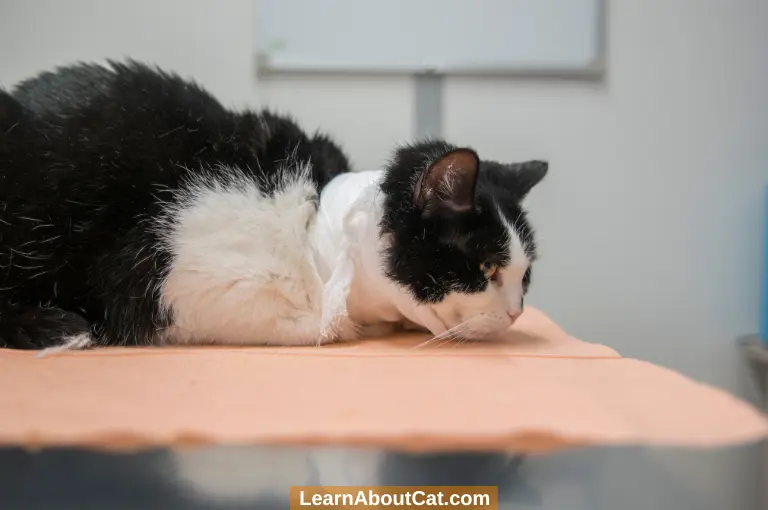
The first step is to consult a veterinarian to rule out a medical ailment, particularly if your cat struggles to pee. Your veterinarian will inspect your cat, inquire about any observations you’ve made at home, and, if necessary, perform diagnostic tests.
When your pet has been diagnosed, it’s critical to carefully follow any medication or follow-up visit instructions provided by your veterinarian.
When medical causes of your cat’s behaviour have been ruled out, it’s important to think about any potential sources of stress. In addition to the family, a new pet or person is a frequent source of worry for cats. Additionally, guests, feral cats, and home renovation projects can stress out cats.
Give your cat lots of attention daily to make them feel more at ease. Ensure that your home has enough beds, litter boxes, and toys so your cat won’t need to compete with other animals for attention.
To lessen tension, think about utilizing cat pheromone items. In severe circumstances, your cat’s veterinarian could recommend anti-anxiety drugs.
Frequently Asked Questions
What are some litter box problems that can cause this behavior?
A dirty litter box, the wrong type of litter, and the litter box’s location can all cause this behavior.
Can diet affect my cat’s litter box habits?
Yes. A diet lacking fiber or moisture can lead to constipation, while excess minerals or magnesium can cause urinary problems. Consult your vet to ensure your cat is on a balanced and appropriate diet.
Why is my cat squatting but not pooping?
Your cat may be crouching but not pooping because of a urethral blockage or other illnesses.
Health conditions, hairballs, a lack of water intake, dietary factors, or even a fear of ambush might cause constipation. On the other side, the urethral blockage might be brought on by crystals, a urinary tract infection, or mucus.
How many times a day should a cat use the litter box?
A cat typically pees and urinates two to three times each day. Although your pet’s frequency of bathroom breaks will vary, it is likely to be near these averages. Seeing your cat use the litter box more frequently than usual is upsetting enough. If he isn’t peeing or urinating, it gets worse.
Why is my cat squatting but only peeing a little?
The cat will repeatedly try to pee but will only produce little to no urine, generally including blood. There may be more severe symptoms in the obstructed cat.
Your cat is crouching but not peeing because of a clog in his urinary tract. Feline lower urinary tract disease in cats (FLUTD) When you see your cat attempting or unable to urinate, you can tell they are uncomfortable. Contact your vet within 24 hours to treat the issue.
Final Words!
Cats are masters at hiding any disease-related symptoms, and of course, they cannot communicate orally with humans about their issues. As a cat owner, you must pay close attention to your feline friend and take any odd behaviour or warning signs seriously.
If your cat continues to use the litter box despite nothing changing, don’t be afraid to share your concerns with your veterinarian because this is not normal. Making ensuring your cat receives the care they need is your responsibility.
Related Posts:
Who is Isabella?
My name is Isabella, and I am a dedicated and knowledgeable cat enthusiast. With years of experience caring for cats and a deep love for felines, I made a mission to help other cat lovers navigate the challenges of cat ownership.

